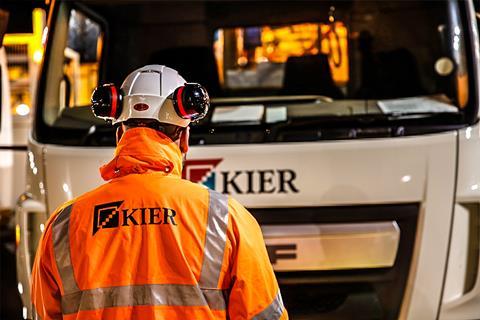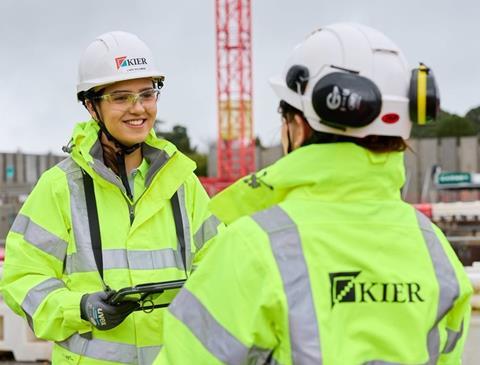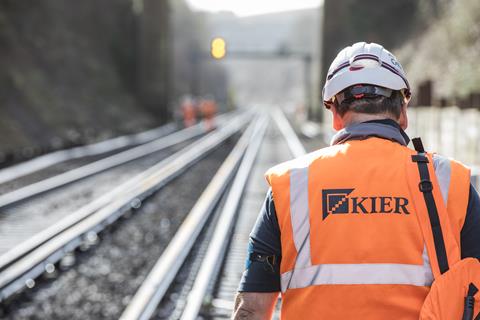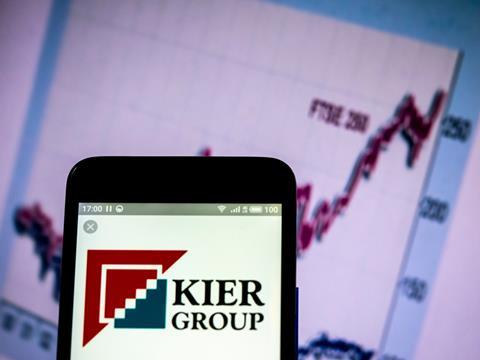The contractorвАЩs chief executive goes in to bat for construction. ItвАЩs a good time to be in the business, he tells Dave Rogers

Andrew Davies has one or two things that he wants to get off his chest. The industry is not broken, as others have claimed, and itвАЩs just not true that the industry canвАЩt build large projects.
вАЬThis industry is absolutely fine,вАЭ KierвАЩs chief executive says. вАЬI do get a little bit irritated. This industry is not broken. People should stop saying that. I get frustrated by people saying this stuff because itвАЩs simply not true.
вАЬWeвАЩre trying to attract people into the industry, trying to portray it as a great industry with career prospects вАУ and there are great career prospects.вАЭ
ItвАЩs a really good time to be a tier one contractor in the UK now. We have stability with the government, weвАЩve been through the Budget
He goes on: вАЬThese bland statements, вАШthe industry is brokenвАЩ, itвАЩs simply not true. The proof points are our performance, Morgan SindallвАЩs, Balfour BeattyвАЩs, I would suggest.
вАЬI would say itвАЩs a really good time to be a tier one contractor in the UK now. We have stability with the government, weвАЩve been through the Budget. There are lots of known knowns now, as opposed to unknown unknowns.
вАЬYou look at our recovery, look at Morgan Sindall, Balfour Beatty. Look at the public companies who are contractors for government and the responsible way the big three are driving performance. This industry is absolutely fine.вАЭ
What about the countryвАЩs perceived problems building large-scale contracts? вАЬPeople jump to conclusions about large projects. вАШThe UK canвАЩt do it.вАЩ Not true.
вАЬLook at the Elizabeth line вАУ it was a massive success. Yes, it had its issues and thereвАЩs a lesson to be learnt, no question about that in terms of systems integration. HS2 needs to learn those lessons. Look at what weвАЩre doing at Hinkley. But we do have to stop this dismal language that the industry is broken.вАЭ
Davies is not one to lecture or court the limelight, but he speaks from a position of strength, having painstakingly brought Kier вАУ one of the вАЬbig fourвАЭ UK builders along with Balfour Beatty, Morgan Sindall and privately-owned Laing OвАЩRourke вАУ back from the abyss over the past few years. And that makes him well worth listening to.
Before arriving at Kier, he had been due to take up the post of Carillion chief executive вАУ his previous employer, Wates, had let him go early in order to help out their teetering rival вАУ but a week before he was due to start, Carillion went bust. CarillionвАЩs loss, then, was very much KierвАЩs gain.
The companyвАЩs woes came hard on the heels of the Carillion collapse and at his first annual results presentation with Kier, Davies was forced to preside over a ¬£245≥Њ loss for the year to June 2019. At his most recent one, in September this year, he was able to say that the firmвАЩs recovery was complete, the symbol of which for many was the payment of its first annual dividend in six years.

The firmвАЩs average month-end net debt at one stage stood at close to ¬£550m, but it has since been hacked down to ¬£116≥Њ. Analysts are expecting the company, which returned to the FTSE 250 list of the UKвАЩs biggest quoted companies earlier this year, to return to a net cash position by early 2026.
Last week, in a trading update, Kier said it expected a вАЬsignificant improvementвАЭ on the debt this current financial year.
вАЬWith Kier, I got in early enough to stabilise things,вАЭ Davies says. вАЬThe share price had collapsed, basically. Confidence was shot at that point.вАЭ
Within the space of a few weeks towards the end of 2018, the firm had dropped out of the FTSE 250 and bungled a rights issue to tackle its mounting debt. It was not fully taken up, leaving City institutions to pick up the slack.
They were trying to overgrow the business, acquiring companies using the balance sheet to do that
These setbacks eventually forced the board to act and chief executive Haydn Mursell went at the start of 2019 after four years as boss.
Under Mursell, the firm had gone on a spending spree, which left it with a near £400m debt pile from the cost of the acquisitions. May Gurney cost £221m, highways engineer Mouchel cost £265m and utilities contractor McNicholas, also known as Green Macs, was rumoured to cost a further £15m-£20m.
On his first day in the job in April 2019, Davies ordered a strategic review of the business. He says of the situation he inherited: вАЬThey were trying to overgrow the business, acquiring companies using the balance sheet to do that. They were not well integrated.
вАЬThere was northing wrong with the operating businesses in Kier. They just needed, frankly, to be tightened up and run properly.вАЭ
>> See also: Kier debt: how can a new boss restore its fortunes?
>> See also: Man with a plan: How is Kier faring under Andrew Davies?
>> See also: New phase begins at Kier as confident Davies looks to future after travails of past
So he put a plan in place which, bit by bit, saw a refinancing, its housing business sold, non-core divisions like environmental services shut down, problem contracts worked through, offices closed and staff numbers cut.
вАЬKier was paying its supply chain later than it should have been,вАЭ Davies says. вАЬThat was one of the first things we sorted out. You have to get a supply chain that wants to work for you.вАЭ
A second equity raise in 2021 brought in ¬£241m, Kier Living went for ¬£110m, a host of businesses shut down вАУ вАЬwe exited a lot,вАЭ Davies admits вАУ and problem contracts were dealt with. вАЬWe had some poor quality contracts because discipline had gone. It was not a well-run company.вАЭ
Among its problem jobs were the Broadmoor hospital scheme, the Mersey gateway bridge and a hotel project in the Caribbean. вАЬWhat we were doing building a hotel in the Caribbean is beyond me,вАЭ says Davies, aghast. вАЬThere was a whole set of smaller projects that, when added up, were significant.вАЭ
Closing or selling off bits of the business took revenue down by around ¬£1bn. вАЬWe took the cost base down further and faster as a percentage,вАЭ Davies says.

When he arrived, KierвАЩs workforce was around 19,000 people. Today it is nearer 10,000. While staff at the non-core business were TUPEвАЩd across to new employers, the firm made around 1,700 staff redundant as well.
This included hundreds of staff at its former headquarters, Tempsford Hall, its historic home of more than 50 years which it left in 2020. вАЬI think I went there twice,вАЭ Davies says.
The firm still owns the country house near Sandy in Bedfordshire вАУ which once had 800 of its staff there вАУ but now leases it to other businesses.
The redundancies saved over ¬£100m. вАЬFundamentally we changed our cost base to get margin into our operation to give us the credibility to go to the banks вАУ and that was the grand bargain we did in 2021.
вАЬYou need to put a plan in place which provides believability and stability. ThatвАЩs what we did.
вАЬCreditors gave us time because they wanted their money back. The supply chainвА¶ we paid them more progressively so theyвАЩre happy to work with you вАУ and your employees, you give them faith.
вАЬIf you do get into these issues, youвАЩve got to deal with them very quickly and youвАЩve got to be very clear with all of your stakeholders what your plan is. And then youвАЩve got to have some proof points as to why it works.вАЭ
He says the steps taken to fix its balance sheet in 2021 led to clients coming back. вАЬItвАЩs no coincidence that at that point in time our order book absolutely rocketed because people returned to Kier. ThatвАЩs what happened.вАЭ
London is a minority [of our work] but itвАЩs deeply important to us and we value those clients enormously
Davies adds that he was in regular contact with the Cabinet Office as soon as he began righting the ship. вАЬWe [later] got letters from very senior Cabinet Office officials saying how pleased they were when we did the [2021] equity raise and restored our balance sheet to health.вАЭ
Around 70% of its income, which stood at ¬£4bn in the year to this June, is from the government. A further 23% is from regulated industries, such as water, with the remainder from the private sector вАУ including its work for clients such as Derwent and Stanhope in London.
вАЬTheyвАЩre top-quality developers,вАЭ he says. вАЬLondon is a minority [of our work] but itвАЩs deeply important to us and we value those clients enormously. To have a good quality business in London, you need a good mix of public and private.вАЭ
But KierвАЩs mainstays are public sector jobs like schools, hospitals, defence, water, roads, rail. вАЬWeвАЩre the biggest supplier to government in the UK. [With the Budget] the government has put certainty into our marketplace.
вАЬHospitals, schools, defence, justice вАУ our end markets have all been mentioned. There is loads to go at.вАЭ
At last weekвАЩs trading update, Kier said its order book stood at ¬£10.9bn, with 95% of its revenue in its current financial year already secured.
One area where Davies wants to see Kier get into more is property. вАЬBecause of the issues Kier had, weвАЩve been unable to allocate the capital to it. But, by generating strong cashflow, you can allocate more money to it.вАЭ
Its property business buys up land for developments such as residential, logistics and offices. It either flips the land to another developer or builds it out.
вАЬWhat we donвАЩt do is hold onto land. WeвАЩre not a property company,вАЭ Davies says.
Nor does it automatically follow that KierвАЩs construction divisions will be whistled up to build new homes or offices. вАЬWe donвАЩt use our property business to feed the other businesses.вАЭ
He is expecting group revenue to grow by something like 5% every year, which on a ¬£4bn revenue is ¬£200m and more again as income goes up. вАЬYou can only grow as fast as your markets grow.вАЭ
Nevertheless, he is pleased with what he has seen in the Budget. вАЬWeвАЩve got a stable government who have set out their priorities and how theyвАЩre going to pay for it. If you look at where I am as a company, IвАЩve got a sustainable growth strategy and a client who has got a demand for what I do.вАЭ

Kier has been working on a 72km long stretch of railway on HS2 and Davies has some timely words on how the industry вАУ and especially clients вАУ deal with risk and risk transfer in general.
вАЬThe country decided it wanted to build a high speed rail network, and to do that it had to let a certain type of contract,вАЭ he says. вАЬOtherwise, it could let a contract that was risk bearing onto the industry.
вАЬBut, frankly, the industry couldnвАЩt take those risks because there were so many unknowns вАУ so many planning unknowns, so many environmental unknowns, inflationary unknowns, protestor unknowns, ground condition unknowns.вАЭ
The project has come in for criticism for its spiraling costs, with the implication that contractors are picking up easy money. Davies says this is unfair and, anyway, contractors canвАЩt just be expected to take on a heap of risk and told itвАЩs all on them if it goes wrong.
вАЬWhat the UK needs to learn to do is manage within an affordability environment and not announce these projects too early without due diligence and what the cost may actually be. We have to learn to manage expectations of cost and risk, thatвАЩs the issue weвАЩve got to learn better as a country.
вАЬYou canвАЩt just dump risk. You think youвАЩre transferring risk but, of course, youвАЩre not because it will come back to you.
вАЬIf you want to transfer risk onto industry, thatвАЩs fine. But industry may price it as such that itвАЩs unaffordable because it has to mitigate against all those risks and it may not understand all those risks.
If you look at the public companies who are contractors for government and the responsible way the big three are driving performance, this industry is absolutely fine
вАЬAs a chief executive of a public company, I wouldnвАЩt accept unbounded risk. I wouldnвАЩt do it. IвАЩll only get into fixed price contracts when I understand the risk and, by the way, in [Kier] construction weвАЩre overwhelmingly on fixed price contracts. But 99% of them we get there through a negotiated process of risk allocation.
вАЬUltimately, if the risk breaks [a] company, it goes straight back to the client with bells and whistles, because they then have to start again.вАЭ
Davies is speaking two months after ISG sank into administration, the most high-profile collapse of several in the past year or so вАУ including Buckingham last September which saw Kier pay ¬£10m for its rail business and 180 staff. Kier has taken on around 70 former ISG staff and is being sounded out about picking up some of ISGвАЩs government contracts. вАЬAbsolutely no private,вАЭ Davies adds.
вАЬThis is not a systemic failure,вАЭ he says of ISGвАЩs implosion. вАЬThis is a company failure. This industry is not broken.
вАЬIf you look at the public companies who are contractors for government and the responsible way the big three [Kier, Morgan Sindall, Balfour Beatty] are driving performance, this industry is absolutely fine. These are responsible companies with excellent balance sheets, excellent liquidity, they pay their suppliers on time. My point is that the government has now вАУ in those three вАУ a totally reliable, trustworthy set of suppliers.вАЭ

He ends by reeling off a list of figures: there are around 35,000 people working on its sites every day; it has around 1,000 contracts of which 400 will be live. вАЬItвАЩs an awful lot,вАЭ he admits.
But Davies, who turned 61 last month, says he is undaunted and, Kier shareholders might be relieved to hear, is not going anywhere. вАЬItвАЩs still huge fun, itвАЩs a good time to be in this industry,вАЭ he says. вАЬItвАЩs a great time to be a CEO of a tier one contractor, it really is.вАЭ
KierвАЩs recovery, he underlines, is complete. вАЬItвАЩs all behind us,вАЭ he says of the turnaround.
DaviesвАЩs attention has now turned to shaping the future, rather than fixing the past. But he is not taking his eye off the ball.
вАЬYouвАЩve got to consistently deliver, deliver, deliver. It is now all about performance. Keep recruiting great people and keep training great people вАУ itвАЩs common sense.вАЭ
Then and now
The numbers Andrew Davies presided over at his first results presentation as Kier chief executive in September 2019, compared with the firmвАЩs most recent figures.

2019 results (year to June)
Turnover ¬£4.5≤ъ≤‘
Operating loss ¬£217≥Њ
Pre-tax loss ¬£245≥Њ
Full-year dividend Suspended
Average month-end net debt ¬£422≥Њ
2024 results (year to June)
Turnover ¬£3.9≤ъ≤‘
Operating profit ¬£103≥Њ
Pre-tax profit ¬£68≥Њ
Full-year dividend 5.8p
Average month-end net debt ¬£116≥Њ
Source: Kier



























No comments yet